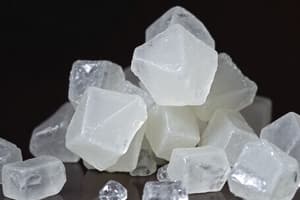Podcast
Questions and Answers
Match each carbohydrate type with its corresponding description:
Match each carbohydrate type with its corresponding description:
Monosaccharides = Single sugars that are the simplest form of carbohydrates. Disaccharides = Double sugars formed when two monosaccharides are joined. Polysaccharides = Complex carbohydrates composed of many sugar molecules linked together. Oligosaccharides = Short chains of a few monosaccharides.
Match the monosaccharide with its correct description:
Match the monosaccharide with its correct description:
Glucose = Primary fuel for the body, found in disaccharides and polysaccharides. Fructose = Fruit sugar found in fruit, honey, and syrup, converts to glucose in the body. Galactose = Part of lactose found in milk, converts to glucose in the body. Mannose = A sugar found in many plants, also important in human metabolism.
Match the disaccharide with its component monosaccharides:
Match the disaccharide with its component monosaccharides:
Sucrose = Glucose + Fructose Lactose = Glucose + Galactose Maltose = Glucose + Glucose Cellobiose = Glucose + Glucose (β-1,4 bond)
Match each polysaccharide with its primary function or source:
Match each polysaccharide with its primary function or source:
Match each type of fiber with its solubility and primary characteristics:
Match each type of fiber with its solubility and primary characteristics:
Match each enzyme with its primary site of action in carbohydrate digestion:
Match each enzyme with its primary site of action in carbohydrate digestion:
Match the enzyme with its corresponding substrate:
Match the enzyme with its corresponding substrate:
Match the absorption mechanism with its characteristics:
Match the absorption mechanism with its characteristics:
Match the transport protein with its function in carbohydrate absorption:
Match the transport protein with its function in carbohydrate absorption:
Match each process with its location in carbohydrate metabolism:
Match each process with its location in carbohydrate metabolism:
Match the volatile fatty acid (VFA) with its percentage composition range in the rumen:
Match the volatile fatty acid (VFA) with its percentage composition range in the rumen:
Match the gas with its percentage composition in the rumen:
Match the gas with its percentage composition in the rumen:
Match rumen bacteria type with its preferred substrate:
Match rumen bacteria type with its preferred substrate:
Match the characteristics with the type of rumen bacteria:
Match the characteristics with the type of rumen bacteria:
Match the site with its role in carbohydrate processing in monogastrics:
Match the site with its role in carbohydrate processing in monogastrics:
Match the carbohydrate with its structure:
Match the carbohydrate with its structure:
Match the compound with its appropriate classification in ruminant nutrition:
Match the compound with its appropriate classification in ruminant nutrition:
Match the effect to the corresponding carbohydrate component influencing glucose metabolism:
Match the effect to the corresponding carbohydrate component influencing glucose metabolism:
Match each gastrointestinal hormone with its function in carbohydrate metabolism:
Match each gastrointestinal hormone with its function in carbohydrate metabolism:
Match each fermentation byproduct to its effect upon bovine rumen function:
Match each fermentation byproduct to its effect upon bovine rumen function:
Match each amylolytic bacterial species to its response during sudden dietary changes in a ruminant diet:
Match each amylolytic bacterial species to its response during sudden dietary changes in a ruminant diet:
Match each enzyme classification with their corresponding digestive functions associated with carbohydrates:
Match each enzyme classification with their corresponding digestive functions associated with carbohydrates:
Match each carbohydrate metabolic pathway with its main end metabolic product:
Match each carbohydrate metabolic pathway with its main end metabolic product:
Match each liver enzyme involved in glucose management to its function, providing insight in glucose balance in metabolism
Match each liver enzyme involved in glucose management to its function, providing insight in glucose balance in metabolism
Categorize each polysaccharide source by digestive capacity associated in a dairy cow:
Categorize each polysaccharide source by digestive capacity associated in a dairy cow:
Categorize the bacteria group for polysaccharide digestibility during digestion stage and location:
Categorize the bacteria group for polysaccharide digestibility during digestion stage and location:
Classify the site of location versus function to correlate with each metabolic process regarding ruminant carbohydrate:
Classify the site of location versus function to correlate with each metabolic process regarding ruminant carbohydrate:
Match each bacteria function or effect to each process of metabolism that is related to volatile fatty acid in animals:
Match each bacteria function or effect to each process of metabolism that is related to volatile fatty acid in animals:
Describe digestive area and their importance for balancing each environment and absorption for carbohydrate intake in livestock:
Describe digestive area and their importance for balancing each environment and absorption for carbohydrate intake in livestock:
Match each digestion byproduct that has process within digestion ruminants with the effects to rumination digestion:
Match each digestion byproduct that has process within digestion ruminants with the effects to rumination digestion:
Match and categorize carbohydrate fermentation patterns alongside each rumen pH and digestive process that correlates with animal.
Match and categorize carbohydrate fermentation patterns alongside each rumen pH and digestive process that correlates with animal.
Match description relating to each enzyme that promotes liver digestion that contains crucial digestion processing.
Match description relating to each enzyme that promotes liver digestion that contains crucial digestion processing.
Match the process alongside description relates about liver that affects glucose absorption in the digestive tract.
Match the process alongside description relates about liver that affects glucose absorption in the digestive tract.
Each bacteria has unique function for digestion , that shows effect as part of polysaccharide . So correlate bacteria with description that matches to each type.
Each bacteria has unique function for digestion , that shows effect as part of polysaccharide . So correlate bacteria with description that matches to each type.
Match the definition that correlates fiber digestive capacity.
Match the definition that correlates fiber digestive capacity.
Match the term that is related to carbohydrate types with description correlating energy effect within the body.
Match the term that is related to carbohydrate types with description correlating energy effect within the body.
Match each carbohydrate type with its primary source or function:
Match each carbohydrate type with its primary source or function:
Match the enzyme with the primary carbohydrate it helps to digest:
Match the enzyme with the primary carbohydrate it helps to digest:
Match each volatile fatty acid (VFA) with its approximate percentage composition in the rumen:
Match each volatile fatty acid (VFA) with its approximate percentage composition in the rumen:
Match the type of bacteria in the rumen with the primary substrate it ferments:
Match the type of bacteria in the rumen with the primary substrate it ferments:
Flashcards
Carbohydrates
Carbohydrates
Composed of carbon, hydrogen, and oxygen, these are energy-providing nutrients.
Monosaccharides
Monosaccharides
Single sugars like glucose, fructose, galactose, and mannose.
Disaccharides
Disaccharides
Double sugars, including sucrose, maltose, and lactose.
Polysaccharides
Polysaccharides
Signup and view all the flashcards
Glucose
Glucose
Signup and view all the flashcards
Fructose
Fructose
Signup and view all the flashcards
Galactose
Galactose
Signup and view all the flashcards
Sucrose
Sucrose
Signup and view all the flashcards
Lactose
Lactose
Signup and view all the flashcards
Maltose
Maltose
Signup and view all the flashcards
Glycogen
Glycogen
Signup and view all the flashcards
Starch
Starch
Signup and view all the flashcards
Fiber
Fiber
Signup and view all the flashcards
Insoluble Fiber
Insoluble Fiber
Signup and view all the flashcards
Soluble Fiber
Soluble Fiber
Signup and view all the flashcards
NFE (Nitrogen-Free Extract)
NFE (Nitrogen-Free Extract)
Signup and view all the flashcards
Salivary Amylase (Ptylin)
Salivary Amylase (Ptylin)
Signup and view all the flashcards
Pancreatic α-amylase
Pancreatic α-amylase
Signup and view all the flashcards
Maltase
Maltase
Signup and view all the flashcards
Isomaltase
Isomaltase
Signup and view all the flashcards
Sucrase
Sucrase
Signup and view all the flashcards
Lactase
Lactase
Signup and view all the flashcards
Active Transport
Active Transport
Signup and view all the flashcards
Facilitative Transport
Facilitative Transport
Signup and view all the flashcards
Major Fiber Components
Major Fiber Components
Signup and view all the flashcards
VFAs
VFAs
Signup and view all the flashcards
Acetic Acid Percentage
Acetic Acid Percentage
Signup and view all the flashcards
Propionic Acid Percentage
Propionic Acid Percentage
Signup and view all the flashcards
Butyric Acid Percentage
Butyric Acid Percentage
Signup and view all the flashcards
Cellulolytic Bacteria
Cellulolytic Bacteria
Signup and view all the flashcards
Amylolytic Bacteria
Amylolytic Bacteria
Signup and view all the flashcards
Small Intestine Function
Small Intestine Function
Signup and view all the flashcards
Large Intestine Function
Large Intestine Function
Signup and view all the flashcards
Study Notes
- Carbohydrates are composed of carbon, hydrogen, and oxygen.
- They are an energy-providing nutrient.
- A diet should consist of 70-80% carbohydrates.
- Carbohydrates must be in the animal's diet daily.
Carbohydrate Types
- Simple carbohydrates are monosaccharides or disaccharides.
- Monosaccharides are single sugars.
- Disaccharides are double sugars.
- Complex carbohydrates are polysaccharides, containing many sugars.
Simple Carbohydrates: Monosaccharides
- Monosaccharides include hexoses which are six-carbon sugars, and pentoses, which are five-carbon sugars.
- The formula (C6H12O6) describes monosaccharides like glucose, fructose, galactose, and mannose.
Glucose
- Glucose is also called dextrose or blood sugar.
- The primary fuel source for the body.
- Found in all disaccharides and polysaccharides.
- Fructose and sucrose are sweeter than glucose.
- Found in combination with other compounds in nature.
Fructose
- Fructose, also known as fruit sugar, is found in fruit, honey, and syrup.
- Can be converted to glucose in the body.
Galactose
- Galactose is a component of lactose, and it can be found in milk.
- The body converts galactose into glucose.
- It is found in combination with lipids in nervous tissue.
Simple Carbohydrates: Disaccharides
- Sucrose, maltose, and lactose are disaccharides.
Sucrose
- Sucrose, commonly known as table sugar, is composed of glucose and fructose.
- Refined from sugar beets and cane.
Lactose
- Lactose, or milk sugar, consists of glucose and galactose.
- Lactose intolerance occurs when there is missing digestive enzymes, required to split lactose into monosaccharides for absorption.
Maltose
- Maltose, is know as malt sugar, it is made up of glucose and glucose.
- Found in germinating seeds.
- Used during the fermentation process to produce malted beverages
Complex Carbohydrates: Polysaccharides
- Glycogen, starches, and fibers are forms of polysaccharides.
Glycogen
- Glycogen are chains of glucose found in animals.
- Stored in the liver and muscles.
- Helps maintain blood glucose levels.
- Represents a "quick energy" source during exercise, lasting only about 12 hours.
Starch
- Starch is long chains of glucose found in plants.
- Found in cereal grains, legumes, and root vegetables.
Fiber
- Fiber consists of mostly indigestible carbohydrates like lignin.
- Fiber is a component of plant cell walls.
- Classified by its differing solubility in water.
- Found in wholegrains, legumes, and fruits.
- Insoluble fiber is non-viscous, examples being cellulose and lignin.
- Soluble fiber is viscous and fermentable, examples including pectins.
Carbohydrate Digestion (Monogastrics)
- Non-Fiber Extract (NFE) refers to soluble carbohydrates, starches, and sugars.
- Digestion occurs through enzymatic processes.
- Carbohydrates are broken down into hexoses such as glucose.
- This process primarily occurs in monogastric animals within the small intestine.
Digestion in the Mouth
- The digestion of carbohydrates begins in the mouth as the salivary glands secrete α-amylase (ptylin).
- This enzyme initiates the hydrolysis of starch.
- During mastication, salivary α-amylase acts on dietary starch, breaking α-(1 → 4) bonds and hydrolyzing starch into dextrins.
Digestion in the Stomach
- Carbohydrate digestion temporarily pauses in the stomach due to the high acidity which inactivates salivary α-amylase.
Digestion in the Intestine
- In the small intestine carbohydrate digestion continues because of enzymes from the pancreas.
- There are two phases of this digestion; one from pancreatic α-amylase, and the other from intestinal enzymes.
- Intestinal enzymes involved are sucrase, maltase, lactase, and isomaltase.
Digestion due to pancreatic α-amylase
- Pancreatic α-amylase degrades dextrins into maltose, isomaltose, and α-limit dextrin.
- The α-limit dextrins are small oligosaccharides containing 3 to 5 glucose units.
Digestion due to intestinal enzymes
- Enzymes that break down carbohydrates are in the brush-border membrane.
End Products of Digestion
- The end products of carbohydrate digestion are glucose, fructose, and galactose.
- Absorbed through intestinal mucosal cells into the bloodstream.
Absorption of Carbohydrates
- Carbohydrates are absorbed as monosaccharides from the intestinal lumen.
- The absorption of monosaccharides occurs through active transport and facilitative transport.
- Glucose moves against a concentration gradient.
- Facilitative transport moves with a concentration gradient.
Active Transport
- Glucose and galactose are actively transported across the brush border membrane of mucosal cells.
- Requires energy, a specific transport protein plus the presence of sodium ions.
- A sodium dependent glucose transporter (SGLT-1) binds glucose and Na+ at separate sites.
- They are transported together through the plasma membrane of the intestinal cell.
- Na+ moves down its concentration gradient.
- Glucose is transported against its concentration gradient.
- Energy for transport is obtained from ATP hydrolysis which links to a sodium pump.
- The sodium pump expels Na+ from the cell in exchange for K+.
Facilitative Transport
- Fructose and mannose use Na+ independent facilitative diffusion through a glucose transporter, GLUT-5.
- Glucose and galactose can also use this same transport, but it relies on a favorable concentration gradient.
Carbohydrate Transport
- The sodium-independent transporter GLUT-2 helps move sugars out of mucosal cells, into the portal circulation and to the liver.
Carbohydrate Digestion (Ruminants)
- A ruminant's diet is composed from cellulose, hemicellulose, and lignin.
- Complex CHO is broken down by rumen microbes.
- This breakdown process produces VFAs and gasses.
Carbohydrate Digestion in Ruminants
- Occurs through microbial fermentation in the rumen.
- Plant material gets fermented into simple sugars.
- Microbes utilize simple sugars and produce waste products Gases, heat, and VFAs.
- Ratios of VFAs depend on the type of diet consumed.
Composition of VFAs in the Rumen
- Acetic acid accounts for 60-70% of the composition.
- Propionic acid accounts for 15-20%.
- Butyric acid accounts for 10-15%.
Composition of gases in the Rumen
- Carbon dioxide makes up 76%.
- Methane is 22%
- Hydrogen is 2%
- Oxygen and nitrogen are in small amounts from ingested air.
- VFAs are absorbed from the rumen, reticulum, and abomasum.
Microbial Populations
- Cellulolytic bacteria ferment plant fiber or cellulose.
- Pectinolytic bacteria ferment plant fibre or pectins.
- Hemicellulolytic bacteria ferment plant fibre or hemi-cellulose.
- Amyolytic bacteria ferment starch.
- Ureolytic bacteria ferment urea.
- Proteolytic bacteria ferment proteins.
Cellulolytic Bacteria
- Cellulolytic bacteria produce cellulase.
- The main substrate for these bacteria is cellulose.
- They mainly produce acetate, with some propionate and little butyrate.
- These bacteria thrive in a pH of 6-7.
- Cellulolytic bacteria are in animals fed roughage diets
Amylolytic Bacteria
- Amylolytic bacteria digest starches and sugars.
- These bacteria prefer a pH of 5-6.
- Amylolytic bacteria produce mainly propionate, plus less butyrate and sometimes lactate.
- Are found in animals fed grain diets.
- Rapid changes to a grain diet causes lactic acidosis due to a rapid decrease in pH.
- An example is Streptococcus bovis.
Small Intestine
- The location of secretions of digestive enzymes.
- Digestive secretions are from pancreas and liver.
- The site of further digestion of carbohydrates.
- Absorption of H2O, minerals, amino acids, glucose, and fatty acids occur here.
Large Intestine
- Bacterial population ferments undigested products.
- Absorption of H2O and VFA, along with the formation of faeces takes place in the large intestine.
Studying That Suits You
Use AI to generate personalized quizzes and flashcards to suit your learning preferences.




